IMO those models are primarily for the education market, and you're paying for the Keysight or Tektronix name. They'll be functional, but you should read or watch a few reviews about them before purchasing to know what you're getting into.
For a bit less money you're able to get a better new scope with Siglent:
Siglent Digital Oscilloscopes SDS1000X-E Series, UK Main Supplier
Or Rigol:
Rigol DS1054Z 50MHz Digital Oscilloscope
Of the two, there have been specific recommendations in this thread for:
- Siglent SDS1202X-E
- Siglent SDS1104X-E
With the 1104X-E getting some good reviews. You wouldn't go wrong with either of those.
If you're just starting there's a really great series of how to use an Oscilloscope for audio work from Blueglow:
Oscilloscopes For Audio Bench Work and Testing - 101 Series - YouTube
For a bit less money you're able to get a better new scope with Siglent:
Siglent Digital Oscilloscopes SDS1000X-E Series, UK Main Supplier
Or Rigol:
Rigol DS1054Z 50MHz Digital Oscilloscope
Of the two, there have been specific recommendations in this thread for:
- Siglent SDS1202X-E
- Siglent SDS1104X-E
With the 1104X-E getting some good reviews. You wouldn't go wrong with either of those.
If you're just starting there's a really great series of how to use an Oscilloscope for audio work from Blueglow:
Oscilloscopes For Audio Bench Work and Testing - 101 Series - YouTube
If you’re breaking out the breadboard to learn/try new ideas then more probes will be more useful. Nothing wrong with the Rigol for audio, just more attractive options appeared as higher performing models have moved down in the pricepoint whist offering licence keys to unlock more performance.
In the past the rigol DS1054Z 50Mhz 4 proble scope was the leading model at this pricepoint as it could be unlocked to 100Mhz along with decode features by the DIYer. Siglent then brought out the 1104x-e which offered the same unlocking potential to 200MHz for not much more. The higher price point allowed siglent to employ less constructive design compromises. More scope for the money. Essentially, once unloacked, a better 200MHz for the price of the Rigol. Or close enough. Hence the popularity of the 1104x-e.
Nothing wrong with the 1202x-e only it doesn’t have the the same features inbuilt to unlock.
In the past the rigol DS1054Z 50Mhz 4 proble scope was the leading model at this pricepoint as it could be unlocked to 100Mhz along with decode features by the DIYer. Siglent then brought out the 1104x-e which offered the same unlocking potential to 200MHz for not much more. The higher price point allowed siglent to employ less constructive design compromises. More scope for the money. Essentially, once unloacked, a better 200MHz for the price of the Rigol. Or close enough. Hence the popularity of the 1104x-e.
Nothing wrong with the 1202x-e only it doesn’t have the the same features inbuilt to unlock.
Last edited:
IMO those models are primarily for the education market, and you're paying for the Keysight or Tektronix name. They'll be functional, but you should read or watch a few reviews about them before purchasing to know what you're getting into.
For a bit less money you're able to get a better new scope with Siglent:
Siglent Digital Oscilloscopes SDS1000X-E Series, UK Main Supplier
Or Rigol:
Rigol DS1054Z 50MHz Digital Oscilloscope
Of the two, there have been specific recommendations in this thread for:
- Siglent SDS1202X-E
- Siglent SDS1104X-E
With the 1104X-E getting some good reviews. You wouldn't go wrong with either of those.
If you're just starting there's a really great series of how to use an Oscilloscope for audio work from Blueglow:
Oscilloscopes For Audio Bench Work and Testing - 101 Series - YouTube
i like the look of this one and it isnt a bad price,so i think i will go for this one
many thanks for all of those who came on and gave advise,im sure i will be back once i have it with some questions 😉
Excellent post! Thanks NickJust to recap
Hi Paulappreciate all the comments guys.
Im affraid at this stage most of what you have said has gone over my head, but im sure i will pick it up.
I need something, at least to start with that is going to be easy to learn how to operate, and of course understand what i am looking at.
One of the small wonders of modern times for a hobbyist is this 25Euro DSO below.
Get a 9Vdc wall pack to work with.
A perfect tool for the beginning and one you will never throw away later on.
https://www.ebay.com/sch/i.html?_fr...nc&_odkw=hand+held+oscilloscope+kit&_osacat=0
George
@poundy: You are starting to develop your knowledge and experience. You can't predict what you will need say a year or two years from now; therefore you have such a problem to make a choice.
The upshot is that it really doesn't matter at this point in time what you chose, after some time you'll home in on what you like to do and what you need for that and get the appropriate piece of equipment.
Just get what's cheap, looks nice and get to work ;-)
Jan
The upshot is that it really doesn't matter at this point in time what you chose, after some time you'll home in on what you like to do and what you need for that and get the appropriate piece of equipment.
Just get what's cheap, looks nice and get to work ;-)
Jan
i like the look of this one and it isnt a bad price,so i think i will go for this one
many thanks for all of those who came on and gave advise,im sure i will be back once i have it with some questions 😉
I know you will be thrilled whichever of those you go for.
If you are balancing the budget a bit might I suggest also looking to get a decent audio function generator. Although you can make audio files to play on PC's and mobiles having a stand alone generator is really useful.
I spotted this which reads like it could be new old stock:
TTi TG210 2MHz FUNCTION GENERATOR - THURLBY THANDAR SIGNAL INSTRUMENT | eBay
Hi,
if choosing a Siglent scope then consider to add a Siglent function generator in future.
Not only well designed pieces of gear, but Osci and Generator can work together by just connecting them via USB cable, allowing for Bode plotting, storing and replaying of scoped waveforms etc. SDG1032x (14bit) or SDG2042x (16bit) would be a perfect match.
jauu
Calvin
if choosing a Siglent scope then consider to add a Siglent function generator in future.
Not only well designed pieces of gear, but Osci and Generator can work together by just connecting them via USB cable, allowing for Bode plotting, storing and replaying of scoped waveforms etc. SDG1032x (14bit) or SDG2042x (16bit) would be a perfect match.
jauu
Calvin
I know you will be thrilled whichever of those you go for.
If you are balancing the budget a bit might I suggest also looking to get a decent audio function generator. Although you can make audio files to play on PC's and mobiles having a stand alone generator is really useful.
I spotted this which reads like it could be new old stock:
TTi TG210 2MHz FUNCTION GENERATOR - THURLBY THANDAR SIGNAL INSTRUMENT | eBay
Got it(christmas prezzie 😉 )
@poundy: You are starting to develop your knowledge and experience. You can't predict what you will need say a year or two years from now; therefore you have such a problem to make a choice.
The upshot is that it really doesn't matter at this point in time what you chose, after some time you'll home in on what you like to do and what you need for that and get the appropriate piece of equipment.
Just get what's cheap, looks nice and get to work ;-)
Jan
cheers Jan 🙂
https://www.thethingsnetwork.org/fo.../25812d0268adafb481b43e2c1a042cc09f90f24b.pdf
I found this very interesting review of the features and some of the advanced options for filtering and acquisition.
I found this very interesting review of the features and some of the advanced options for filtering and acquisition.
A bit late to the party, however I use a vintage Hitachi V-1065. 100MHz analogue, with a pin sharp CRT. Renders eye pattern nicely if dealing with CDP work, ergonomics are good, and selectable 20MHz b/w to reject HF noise.
Also have an Iwatsu SS-7810, it's OK apart from the slightly soft CRT, not as recommended as the Hitachi, but will get you out of jail if a quick look at something reqd.
Also have an Iwatsu SS-7810, it's OK apart from the slightly soft CRT, not as recommended as the Hitachi, but will get you out of jail if a quick look at something reqd.
I found this very interesting review of the features and some of the advanced options for filtering and acquisition.
When it comes to measuring the amplitude of noisy low level audio frequency signals, please check out the amplitude read-out of the oscilloscope, it may provide erroneous results.
I was checking the measurement readout of my 8 bit Rigol DS1202Z-E using the output signal of my sound card (EMU-0404) as the signal source.
George
Attachments
-
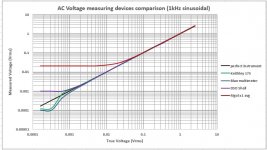 1 all instruments.jpg94.7 KB · Views: 245
1 all instruments.jpg94.7 KB · Views: 245 -
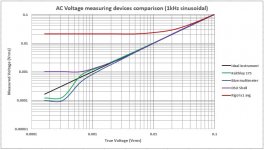 2 instruments.jpg82.5 KB · Views: 238
2 instruments.jpg82.5 KB · Views: 238 -
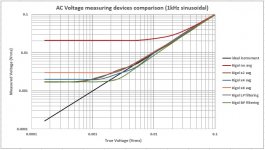 3 Rigol.jpg79.9 KB · Views: 209
3 Rigol.jpg79.9 KB · Views: 209 -
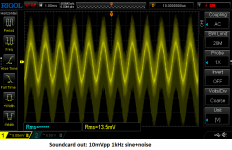 4 10mVpp 1kHz sine+noise.png90.7 KB · Views: 230
4 10mVpp 1kHz sine+noise.png90.7 KB · Views: 230 -
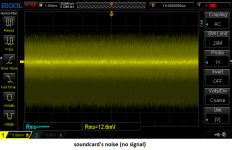 5 noise (no signal).png80.8 KB · Views: 219
5 noise (no signal).png80.8 KB · Views: 219 -
 6 zoom-in on noise.png57.3 KB · Views: 118
6 zoom-in on noise.png57.3 KB · Views: 118 -
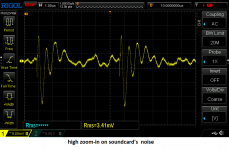 7 high zoom-in on noise.png38.4 KB · Views: 122
7 high zoom-in on noise.png38.4 KB · Views: 122
When it comes to measuring the amplitude of noisy low level audio frequency signals, please check out the amplitude read-out of the oscilloscope, it may provide erroneous results.
I was checking the measurement readout of my 8 bit Rigol DS1202Z-E using the output signal of my sound card (EMU-0404) as the signal source.
George
Good point. What was the impedance of the load?
I would like to learn more on this, especially as DSOs throw a lot of "data" at you, the key is understanding what is good data and what is bad. I've already seen the front end amps distort signals based on offset.
I've worked with metrology folks (national physics laboratory) and the discussions around subject of measurements (in this case optics and electronics) means I'm happy to admit my very kindergarten view 😀
Last edited:
Source was 150 Ohm. Load >10 MOhm.Good point. What was the impedance of the load?
Always, regardless of all the bells and whistles modern DSOs provide us with.the key is understanding what is good data and what is bad.
One way is to have control over the signal you want to measure.
In the case I showed above, I verified that the signal’s noise level was fixed regardless of the sinusoidal signal level. Then starting with a high signal level, I was reducing the signal level in steps of 6dB. As long as the measured value followed the 6dB drop law (halving of the voltage at each step), measurement was reliable.
Very true. I’ve lived with metrologists too.I've worked with metrology folks (national physics laboratory) and the discussions around subject of measurements (in this case optics and electronics) means I'm happy to admit my very kindergarten view 😀
What we are talking here is in comparison, kindergarten stuff.
Nevertheless results may turn embarrassingly wrong.🙁
George
Below 1 mV there are several things that contribute to the uncertainty of your measurement. Noise, measurement resolution of the instrument, stability of everything etc. Measuring small AC signals is difficult and the best suited instrument is a wave analyzer. A spectrum analyzer is second but checking it when you are at the bottom of its range is tricky at best. Most RMS converters are not specified for accuracy below something like 1/3 of the range which probably explains the Keithley result.
Most important is to not believe any instrument blindly. Crosscheck or verify because its easy to miss a detail.
Most important is to not believe any instrument blindly. Crosscheck or verify because its easy to miss a detail.
Most important is to not believe any instrument blindly. Crosscheck or verify

George
Below 1 mV there are several things that contribute to the uncertainty of your measurement. Noise, measurement resolution of the instrument, stability of everything etc. Measuring small AC signals is difficult and the best suited instrument is a wave analyzer. A spectrum analyzer is second but checking it when you are at the bottom of its range is tricky at best. Most RMS converters are not specified for accuracy below something like 1/3 of the range which probably explains the Keithley result.
Most important is to not believe any instrument blindly. Crosscheck or verify because its easy to miss a detail.
I’m wondering if you could use phase correlation on the fft from a ADC to obtain the voltage.
I’ve used 2D phase correction strength for deconvolution of astro images. Essentially pulling objects out of the cooled 16bit mono CCD camera noise floor.
Looking at the block process diagram for wave analysis that looks similar.
The smart move is to use a soundcard and some software which can create a narrow band filter. You still need to verify the measurement but with 20+ bits and a big FFT you can measure down pretty deep, but only of the signal does not drift. otherwise its more complicated but i'm sure someone has a solution.
- Home
- Design & Build
- Equipment & Tools
- oscilloscope-Analog or digital


